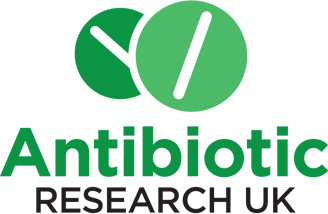Research funded by Antibiotic Research UK is now back on track after a pandemic-related pause. Our project to discover potential antibiotic resistance ‘breakers’ identified one particularly promising combination of treatments. We can now test that combination on samples of bacteria (isolates) taken from infected patients at participating hospitals.
Antibiotic resistance breakers – how do they work?
Resistance breakers are combinations of medicines that, when used together, prevent bacteria from defending themselves against antibiotics. Without a resistance breaker, some bacteria can defend themselves against β-lactam antibiotics such as penicillin. They do this by producing an enzyme (lactamase) that breaks down the β-lactam part of the medicine so that it no longer works. Adding a resistance breaker prevents the enzyme from working, so the antibiotic kills the bacteria.
Why are antibiotic resistance breakers so important?
New antibiotics take many years and billions of pounds to develop. It is more efficient and cost effective to maintain the usefulness of existing treatments. Combining existing medicines means we can get the treatment tested and into patients more quickly.
In this particular combination, the treatment includes:
- A β-lactam antibiotic called Cefepime
- A β-lactamase inhibitor called sulbactam
Dr David Wareham (Queen Mary University of London and our Science Committee), said: “One approach to tackling antibiotic-resistant infections is to revitalise and repurpose older drugs that have largely been abandoned in routine clinical use. We have seen this to be a successful strategy in recent attempts to treat COVID-19. For example, using old anti-inflammatory and antiretroviral drugs. Cefepime and sulbactam are both old beta-lactam antibiotics, developed over 50 years ago, which were either replaced by newer agents or compromised by resistance.
“In this study [the MUTATE study] we have looked at different combinations of cefepime and sulbactam and found them to have activity against many common infections identified in UK laboratories. They may also offer a novel treatment for some of the more resistant community [non-hospital] acquired infections. This includes, for example, those that produce extended-spectrum β-lactamases (ESBLs) and the hospital pathogen Acinetobacter baumannii.
“Although cefepime and sulbactam have an established safety record and a long history of clinical use, we need to undertake further work to determine the optimal dose for the two drugs when combined together. In the second part of the MUTATE study, conducted with partners at Precision AMR (University College London), we are determining the efficacy of different dosing regimens in the treatment of a range of resistant bacteria. If successful we hope to be able to recommend a cefepime/sulbactam combination therapy that can be quickly adopted for the treatment of multi-drug resistant infections in UK patients.”
What is currently happening?
We successfully recruited 18 laboratories prior to the pandemic. Their contributions to the project were, understandably, paused to allow for work on COVID-19 instead. However, since Spring this year things are back on track. Those 18 labs have received study packs, which include test discs.
The University of Warwick and Queen Mary University of London are receiving data and samples from UK labs and hospitals. Later, samples from overseas will be included.
What do the researchers do?

Julie Tod, Senior Research Technician at the University of Warwick (pictured), explains this part of the process:
“Isolates (samples of bacteria from patients) are sent to University of Warwick. Each isolate is used to grow a colony of bacteria that can be used for testing.
A dilution (liquid) of each sample is spread on an agar plate, thus providing the right nutrients for the bacteria to grow and cover the whole surface. Next, a test disc containing the cefepime/sulbactam antibiotics is placed in the centre of these plates, and they are incubated to encourage growth. During incubation the antibiotic diffuses through the agar and thus the bacteria are exposed to the compound(s).
The plates are then observed for:
- Plates containing bacteria that are susceptible to the antibiotic compound on the disc do not grow around the disc itself. This leaves a ‘zone of inhibition’ around the disc (see image below).
- Bacteria that are resistant will still grow around it, leaving a smaller zone of inhibition.”

A plate containing a test disc (the small white circle in the centre). Around this is a clear area of agar jelly: the zone of inhibition. The cloudy area around the edge of the plate is where the bacteria is growing. This shows that the treatment on the disc is effective against this particular bacterial isolate.
So far, six labs have returned data and more than 700 samples, and more are on their way. Early results look very promising.
What’s next?
Discussions are underway regarding a large-scale clinical trial of this combination treatment. That is the next important step towards getting this treatment out into clinical care.
Antibiotic Research UK has awarded University College London a contract to work out the required dose of this potential treatment. The ‘hollow fibre system’ used in this research mimics how blood flows in an infected body. Researchers use this to establish the concentration of drug that will have a meaningful impact on the bacteria.
How can you help?
We are thrilled to see progress in this crucial area of our work; it has the potential to save hundreds or even thousands of lives. All of the progress made so far is thanks to the generous donations we have received. Please support our work and be part of research that could change the world.

